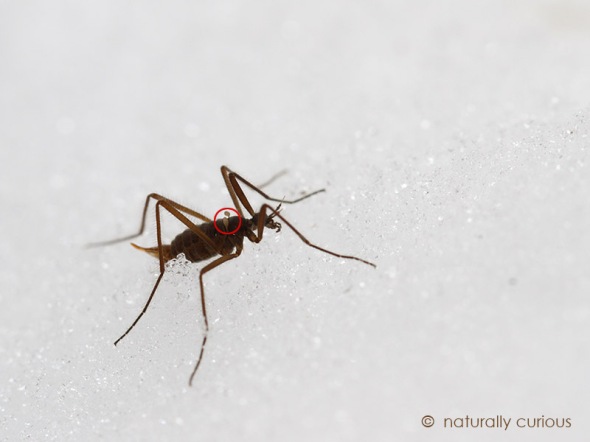Wingless Snow-walking Crane Flies
 Thanks to a sharp-eyed Naturally Curious blog reader, a recently mis-identified active winter insect can be correctly identified. What I referred to as a “snow scorpionfly” last week was, in fact, a type of crane fly that, as an adult, has no wings. Like snow scorpionflies, these wingless snow-walking crane flies appear on top of the snow on warm winter days. These two kinds of insects are also very similar in shape and size, but, unlike snow scorpionflies, this group of crane flies have what are called halteres, knobbed filaments which act as balancing organs (see photo).
Thanks to a sharp-eyed Naturally Curious blog reader, a recently mis-identified active winter insect can be correctly identified. What I referred to as a “snow scorpionfly” last week was, in fact, a type of crane fly that, as an adult, has no wings. Like snow scorpionflies, these wingless snow-walking crane flies appear on top of the snow on warm winter days. These two kinds of insects are also very similar in shape and size, but, unlike snow scorpionflies, this group of crane flies have what are called halteres, knobbed filaments which act as balancing organs (see photo).
Scorpion snowflies, despite their name, are not true flies in the order Diptera. Crane flies are. Most species of true flies have one pair of wings, instead of the usual two that winged insects have, as well as halters, which take the place of hind wings and vibrate during flight. While wingless snow-walking crane flies lack a pair of wings, they do possess halteres, which are the key to distinguishing between a wingless snow-walking crane fly and a snow scorpionfly, which lacks them! (Thanks to Jay Lehtinen for photo I.D.)
Naturally Curious is supported by donations. If you choose to contribute, you may go to http://www.naturallycuriouswithmaryholland.wordpress.com and click on the yellow “donate” button.
Snow Scorpionflies Active
 On mild winter days you may wish to look closely at all the dark, little specks on the surface of the snow. Most of them will be bits of lichen, seeds or pieces of bark, but with luck you may find one or more of them moving. Active winter insects aren’t plentiful, but they do exist.
On mild winter days you may wish to look closely at all the dark, little specks on the surface of the snow. Most of them will be bits of lichen, seeds or pieces of bark, but with luck you may find one or more of them moving. Active winter insects aren’t plentiful, but they do exist.
Scorpionflies are fairly common and can be recognized by their long beaks ending in visible mouthparts. (They get their name from one family of scorpionflies that possesses a scorpion-like tail.) Snow Scorpionflies belong to a family of small, flightless insects, of which there are two species in the Northeast. They only measure about 2/10’s of an inch, so careful scrutiny is necessary to spot one. Their dark color and an anti-freeze substance in their blood allows them to remain active to 21°F., during which time they feed on mosses. When startled, Snow Scorpionflies often jump up in the air and land with their legs crumpled up (see insert) looking even more like an inedible speck of dirt. It’s fairly easy to tell their gender, as female Snow Scorpionflies (photo) lack wings, and males have bristly wings adapted for grasping females.
Naturally Curious is supported by donations. If you choose to contribute, you may go to http://www.naturallycuriouswithmaryholland.wordpress.com and click on the yellow “donate” button.


















What Other Naturally Curious People Are Saying